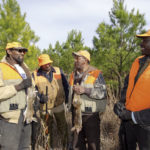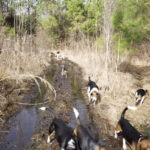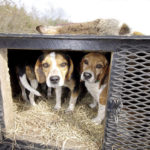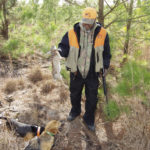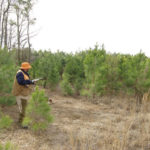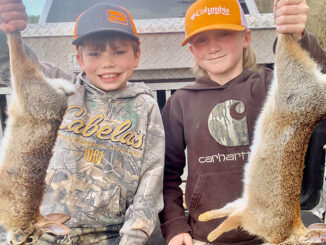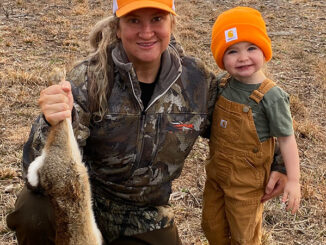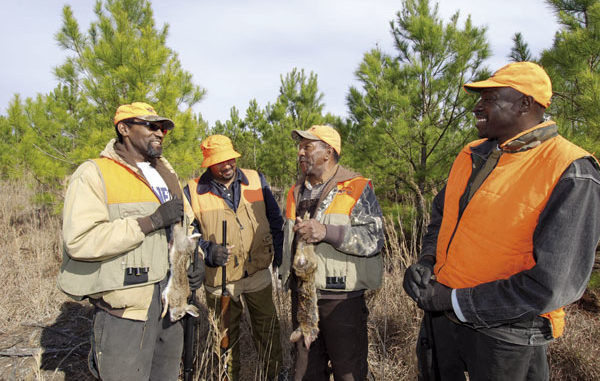
The Horsemen Hunting Club has expanded to 15 members, proving rabbit hunting is still popular in the Tar Heel State.
A covey of pickup trucks nestled in the back of a Duplin County farm field, the beds sporting dog boxes empty but for the musty remaining scent of beagles. But the howls, yips and yelps from the thick piney woods surrounding the field revealed where the kennels’ occupants were and what they were doing.
Roland Boney Jr. was in the woods, waiting for one of his beagles to run a rabbit into one of the scarce open areas within the 15-year-old pine stand. He is president of the Horsemen Hunting Club, one of five charter members along with Belton Herring, James Vines, Donald Ray Carroll and Terrial White.
“There were five original hunters, so we used to be the Five Horsemen Hunting Club,“ Boney said. “Now we have about 15 members, so we had to change the name.”
Most members are related, close friends or neighbors, but the club is open to anyone who wants to join. Boney said he and other club members have taken lots of people who want to try hunting rabbits. They keep trying to get children interested in rabbit hunting.
“Most of us started out hunting when we were kids and have stuck with it,” he said. “We hunt deer, squirrels and other game, but like our motto says, ‘When we turn out our beagles, we hunt strictly rabbits.’ ”
Boney said the group has most of its best hunts after deer season ends.
“It’s always easier to get permission to hunt after deer season ends,” he said. “We mostly hunt private farms like this one, but we also go on guided hunts and hunt game lands. We hunt every season in South Carolina and travel to hunt anywhere there are a few rabbits and we can get permission.”
The farm where Boney had turned beagles loose was near Rose Hill, in the heart of southeastern North Carolina’s farm country.
“I think we have about 40 dogs in the woods right now,” he said. “The more the merrier. Rabbit hunting is all about listening to the dogs run.”
Carroll slipped along a woods trail that a deer hunter had used to access his stand. Other than the trail, there was no other place where he could see, let alone shoot, a rabbit.
“You have to be careful to stay out of the line of fire of another hunter,” Carroll said. “You hunt around the trail bends from each other, or hunt back-to-back, facing away from each other.”
Carroll had already shot a cottontail rabbit and a marsh rabbit. He showed the bluish tail of the marsh rabbit and explained that was the reason he called marsh rabbits “bluetails.”
“Some people say a bluetail doesn’t taste as good as a cottontail,” he said, “but I can’t tell the difference, once you stew them or fry them up.”
The hunters use light loads for rabbits. Boney carries a 20-gauge Remington 1187 semi-automatic loaded with No. 7½ shot.
“You don’t need much of a load to kill a rabbit,” he said. “The trick is hitting him. You pick a hole where he will run through and keep shooting until you don’t see him. Then he’s either down or he’s gone on his way. You go over to the spot where you saw him last, trying to get there before the beagles, or they might chew him up. If they keep going, you missed the rabbit.”
A typical hunt lasts three or four hours. The Horsemen like to hunt in the morning before the sun heats up and after rabbits have been moving during the predawn. But some hunts may last all day if the hunters and dogs are willing and the weather is cool.
“The morning gives the best scent conditions so the dogs can cold-trail the rabbits to their beds and jump them,” White said. “When they get one going, they wake the entire woods up. A good jump dog is the hardest kind of dog to find. Once a jump dog has the rabbit running, all the other dogs join in. I love hearing them as they run.”
White is an expert rabbit hunter like Boney. He said wearing briar-proof clothing and gloves is helpful for slipping through the briars and vines of the thick cover.
“You find a stump or wind-row to get on top of to give you some elevation if you can,” he said. “Anywhere there’s an opening is a good place to stand and wait. Sooner or later, a rabbit will come out where someone can get a shot.
“We usually have about seven hunters along for a hunt. When they’re spaced out in front of the dogs, it’s not long before someone will get a shot, unless it’s a marsh rabbit. A marsh rabbit will stay where it’s too thick to get a shot. Someone will eventually have to go in after him, and the shot will be at close range. In that case, you try to hit him in the head.”
A shot followed by a shout to rally the beagles told of a successful chase. Joe Kelly was holding up a rabbit by its hind legs, allowing them to nip its ears and get a whiff of scent.
“Now the dogs know we got this rabbit, so they will head off to find another one,” Kelly said.
Boney, a farmer, tends approximately 300 acres of corn, wheat and soybeans. He hunts his farm early in the season, then begins hunting other places as deer season ends.
“Anywhere they plant crops where the fields are bordered by dense trees and brush or overgrown fields is a good place to find rabbits,” he said. “I look for rabbit balls and rabbit tracks in the woods nearby. Rabbit balls will be everywhere in good cover. I see them on top of stumps and logs, on the ground and in the grass. If you find where a rabbit left his calling cards, he won’t be very far away, and the dogs will sniff him out.”

